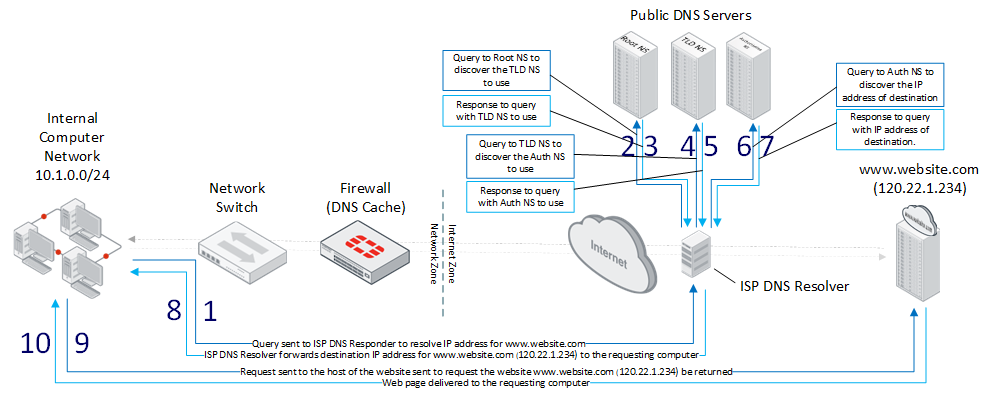Understanding how the Domain Name System (DNS) translates domain names into IP addresses. This includes client queries, resolver processes, DNS caching, and the interaction between DNS servers.
Domain Name System (DNS) is a critical component of the internet infrastructure, responsible for translating human-readable domain names (like www.example.com) into IP addresses that computers use to identify each other on the network. Understanding DNS involves knowledge of client queries, resolver processes, DNS caching, and the interactions between various DNS servers.

How DNS Works
- Client Queries: When a user types a URL into a browser, the client (e.g., the user’s device) needs to find the corresponding IP address. This process starts with a DNS query.
- DNS Resolver: The DNS resolver, often provided by the user’s ISP or a third-party DNS service (e.g., Google Public DNS), is responsible for handling the client’s DNS query. The resolver can answer the query from its cache or forward it to other DNS servers.
- DNS Caching: DNS resolvers and clients cache the responses to DNS queries to reduce latency and minimize the load on DNS servers. Cached entries have a Time to Live (TTL) value that indicates how long they should be kept before being discarded.
- Interaction Between DNS Servers: If the resolver doesn’t have the answer in its cache, it follows a recursive process to find the IP address:
- Root DNS Servers: The resolver starts by querying one of the root DNS servers. There are 13 root server clusters worldwide, identified by letters (A through M). These servers don’t know the specific IP address but can direct the resolver to the appropriate top-level domain (TLD) server (e.g., .com, .org).
- TLD DNS Servers: The resolver then queries the TLD server for the domain in question. The TLD server directs the resolver to the authoritative DNS server for the specific domain.
- Authoritative DNS Servers: The authoritative DNS server for the domain holds the actual DNS records (A, AAAA, CNAME, etc.) that map the domain name to its IP address. The resolver retrieves the IP address from this server and returns it to the client.
Detailed Steps of a DNS Query
- Client Request: The client sends a DNS query to the DNS resolver configured on its network settings.
- Resolver Cache Check: The resolver checks its cache to see if it has a recent answer. If it does, it returns the cached IP address to the client.
- Root Server Query: If the answer is not in the cache, the resolver queries a root DNS server.
- TLD Server Query: The root server responds with the IP address of the TLD server (e.g., for .com domains).
- Authoritative Server Query: The resolver queries the TLD server, which responds with the IP address of the authoritative DNS server for the specific domain.
- Retrieve DNS Record: The resolver queries the authoritative DNS server, which provides the IP address associated with the domain name.
- Return IP Address: The resolver caches the IP address and returns it to the client.
- Client Uses IP Address: The client uses the IP address to establish a connection with the target server.
DNS Record Types
- A Record (Address Record): Maps a domain name to an IPv4 address.
- AAAA Record: Maps a domain name to an IPv6 address.
- CNAME Record (Canonical Name Record): Alias of one name to another. The DNS lookup will continue by retrying the lookup with the new name.
- MX Record (Mail Exchange Record): Specifies the mail server responsible for receiving email messages on behalf of a domain.
- TXT Record: Provides text information to sources outside the domain, often used for email validation like SPF, DKIM, and DMARC.
DNS Caching
- Client-Side Caching: The client’s operating system or application caches DNS responses to reduce query times.
- Resolver Caching: The DNS resolver caches responses to speed up subsequent queries from any client. Cached entries are stored for the duration of their TTL.
DNS Security
- DNSSEC (DNS Security Extensions): Adds a layer of security to prevent certain types of attacks by ensuring that responses to DNS queries are authentic and have not been tampered with.
- DNS over HTTPS (DoH) and DNS over TLS (DoT): Encrypt DNS queries to protect user privacy and security by preventing eavesdropping and manipulation of DNS data.
Summary
Understanding DNS involves knowing how domain names are translated into IP addresses through a process involving client queries, resolver interactions, caching mechanisms, and the hierarchical structure of DNS servers. This knowledge is fundamental for troubleshooting network issues, improving network performance, and ensuring secure communication.
